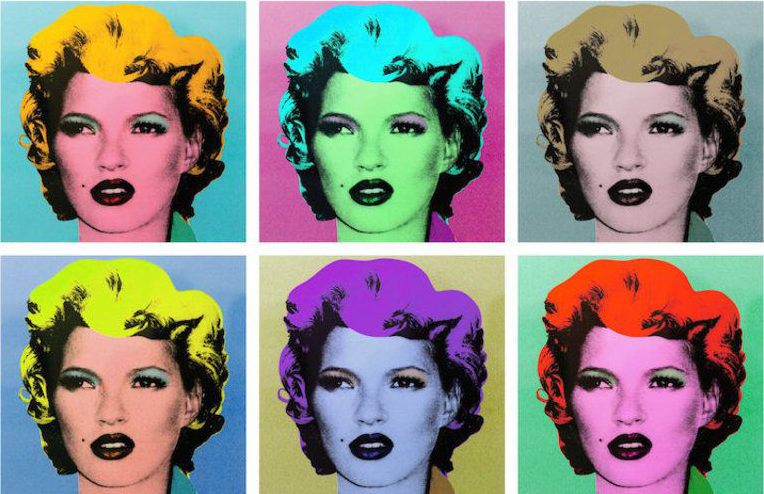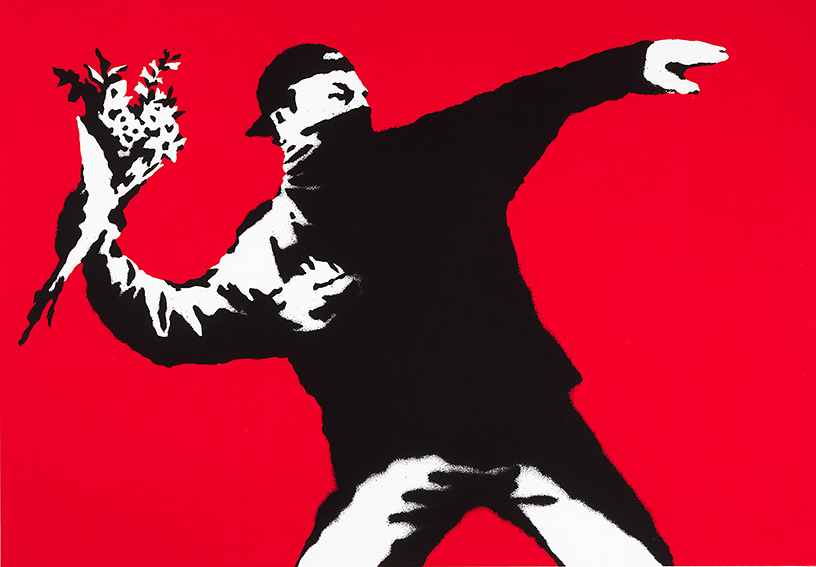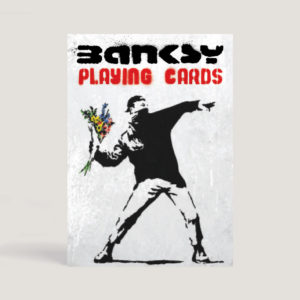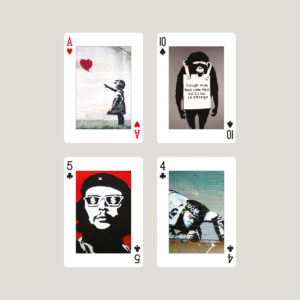‘People say graffiti is ugly, irresponsible & childish. But that’s only if it’s done properly.’
 Possibly the Daily Mail is right and Banksy is a bloke called Robin Gunningham, a native of Bristol, where his street art emerged in the early 1990s. Does it matter who he is? Paradoxically, his anonymity makes him famous. An air of mystery fans media interest in this Pimpernel of the pavements, sneaking out with stencil and spray gun to illuminate a pub wall with kissing policemen, or a terraced house with Mona Lisa’s bum. Often he uses street furniture in his work – like the burglar alarm that serves as the earring in his recreation of Vermeer’s Girl with a Pearl Earring, on a house near Bristol docks. He comes like a thief in the night, but not to steal. He’s an urban Robin Hood, giving to the people gifts of graphic art ranging from simple smut to polemical rants, defending his vehemence by quoting an unlikely hero, Barry Goldwater – ‘Extremism in defense of liberty is no vice’.
Possibly the Daily Mail is right and Banksy is a bloke called Robin Gunningham, a native of Bristol, where his street art emerged in the early 1990s. Does it matter who he is? Paradoxically, his anonymity makes him famous. An air of mystery fans media interest in this Pimpernel of the pavements, sneaking out with stencil and spray gun to illuminate a pub wall with kissing policemen, or a terraced house with Mona Lisa’s bum. Often he uses street furniture in his work – like the burglar alarm that serves as the earring in his recreation of Vermeer’s Girl with a Pearl Earring, on a house near Bristol docks. He comes like a thief in the night, but not to steal. He’s an urban Robin Hood, giving to the people gifts of graphic art ranging from simple smut to polemical rants, defending his vehemence by quoting an unlikely hero, Barry Goldwater – ‘Extremism in defense of liberty is no vice’.
SATIRE AND IRONY
He rages against war, violence, greed, commercialism and capitalism with dark satire and clever irony – ‘We can’t do anything to change the world until capitalism crumbles. In the meantime we should all go shopping to console ourselves.’ Sometimes his graffiti parodies Bushisms – ‘Anyone who believes in capital punishment should be shot’; or adapts Swiftian logic: ‘EAT THE RICH – With our new 2 in 1 offer including a choice of wine.’
They seek him here, they seek him there, the Council seeks him everywhere. For graffiti is an offence, it is deemed ‘vandalism’. But money can seduce the vandalised. On the shutters of Larry Flynt’s strip joint, the Hustler Club in Manhattan, Banksy spray painted a man in a tux, holding a bunch of drooping flowers, entitled ‘Waiting in vain… at the door of the club’. Hustler Club boss Steve Karel removed the shutter saying ‘we will keep it safe from vandals until we can display it inside.’ He knew its worth.
BANKSY AND MONEY
 Accused of vandalism Banksy counter attacks against ‘brandalism’, the false god of advertising, seducing the gullible into wanting what they don’t need. That does not mean that Banksy is unaware of the commercial potential of his work, and he adapts many of his street designs for prints, which now fetch whopping prices. Andy Warhol said: ‘Making money is art and working is art and good business is the best art.’ Warhol’s influence is evident, not just in the homage Banksy pays Warhol in the Kate Moss series, but in Banksy’s graphic style, wit and ingenuity, and his use of multimedia, of print and film and paint and stencil. Warhol was not anonymous but was a vacuum, a sort of Forest Gump, occasionally issuing impenetrable bon mots like everyone being famous for fifteen minutes, or ‘Art is what you can get away with’.
Accused of vandalism Banksy counter attacks against ‘brandalism’, the false god of advertising, seducing the gullible into wanting what they don’t need. That does not mean that Banksy is unaware of the commercial potential of his work, and he adapts many of his street designs for prints, which now fetch whopping prices. Andy Warhol said: ‘Making money is art and working is art and good business is the best art.’ Warhol’s influence is evident, not just in the homage Banksy pays Warhol in the Kate Moss series, but in Banksy’s graphic style, wit and ingenuity, and his use of multimedia, of print and film and paint and stencil. Warhol was not anonymous but was a vacuum, a sort of Forest Gump, occasionally issuing impenetrable bon mots like everyone being famous for fifteen minutes, or ‘Art is what you can get away with’.
CONSUMERISM
Banksy blurs things like graffiti and art, just as Warhol blurred the distinction between art and advertising. Whereas Banksy may seem, like Warhol, to elevate packaging to art in his Tesco soup tin (a tribute to Warhol’s Campbell’s soup can) the arty seriousness of the image, like that of Banksy’s Tesco petrol bomb, is ironic, for Banksy detests consumerism, particularly the aggressive consumerism of Tesco’s and McDonald’s. And he hates the art market. ‘Modern art is a disaster area. Never in the field of human history has so much been used by so many to say so little.’ He summed this up in a mural of a bored museum attendant sitting next to a gilt framed canvas with ‘ARSE’ scrawled on it; and in a print of a pompous auction where a painting is entitled ‘I can’t believe you morons actually buy this shit’. Not subtle but effective.
BUYING BANKSY
Despite his loathing of the art market, its arbitrary fads and commercialism, his own pictures sell on the basis of his name, but with a certificate to go with it. He proved the point in New York. During his self-proclaimed ‘residence’ on its streets, which he named ‘Better Out Than In’, he manned a one-day Central Park pop-up stall selling ‘100% authentic original signed Banksy canvases’ for $60 each. With no caché of a gallery and no certificate there were only three buyers. Estimated value per painting – $200,000. Banksy calls galleries that sell his work ‘unauthorized’, and is represented instead by The Pest Control, which encourages owners concerned about authentication to submit works but warns that ‘because many Banksy pieces are created in an advanced state of intoxication the authentication process can be lengthy and challenging.’ In other words, sod off. As for buying a work from the artist – forget it. ‘Pest Control is now the sole point of sale for new work by Banksy, of which there is currently something/nothing available.’ He explains this unbusinesslike position succinctly, in a typical Banksy paradox: ‘commercial success is a mark of failure for a graffiti artist.’


